Right before the light died I got this picture of begonias growing along the trail, huge begonias, unknown and deathly exciting to a houseplant maven.
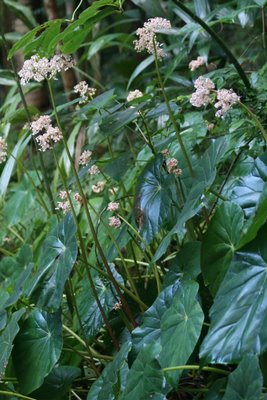 A little oncidium orchid, fallen from high above, bloomed bravely on the forest floor.
A little oncidium orchid, fallen from high above, bloomed bravely on the forest floor.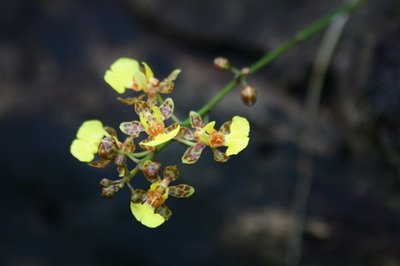
Our guide was amazing. Not a word of English, but he saw every pajarito there was to see, way before we did, and he could whistle through a rolled tongue just like a tinamou or a laughing falcon. I was humbled by his presence, honored to be in his company. He was a woodsman, a rare one. One such pajarito was a red-capped manakin, and I was privileged to be standing beside Mike Bergin (of 10,000 Birds reknown) as he ticked that one off on his life list. If you ever get a chance to go birding with Mike, grab it! Bill and I are already trying to figure out how to enjoy his witty, warm and bright company again soon. He's a live one.
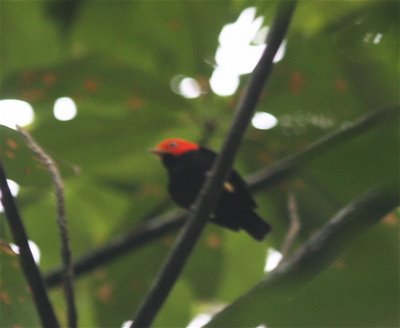 Pity this manakin does not know how famous he is, being Mike Bergin's First Manakin and all. Manakins seem like the kind of birds that would enjoy being notorious.
Pity this manakin does not know how famous he is, being Mike Bergin's First Manakin and all. Manakins seem like the kind of birds that would enjoy being notorious.The unidentified fluffy mass on the tree in this pathetic picture proved to be the nest of a lesser swallow-tailed swift, constructed of plant down and swift saliva. It had a tubular entrance pointing straight down.
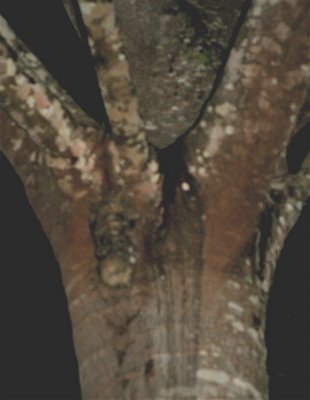 This is what's nice about having people like Steve Howell, author of Birds of Mexico, on one's trip! We'd never have known what it was otherwise. He's also a very fun guy. I wish I had had a chance to go birding with him, but life intervened.
This is what's nice about having people like Steve Howell, author of Birds of Mexico, on one's trip! We'd never have known what it was otherwise. He's also a very fun guy. I wish I had had a chance to go birding with him, but life intervened.An ivory-billed woodcreeper searched for insects. I love the fine pearls running over his shoulder and mantle.
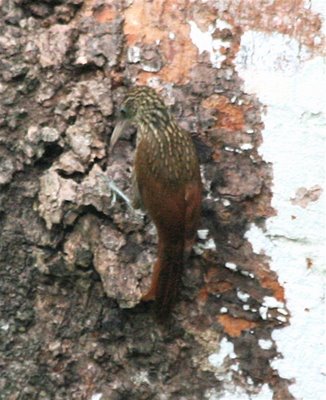
The best was yet to come. Our guide hurried to get us to an archaeological site before it was completely dark. Scrambling up slick stone stairs, we were felled by the vision of a huge eye and nose emerging from jungle vegetation. Wow, wow, wow.
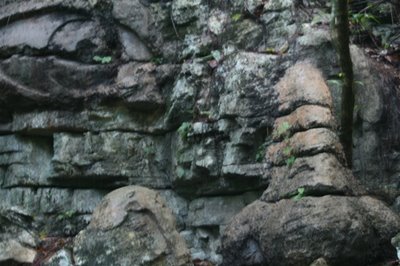
Tikal is cool, but it has nothing to compare to this for sheer grab-you-by-the-psyche impact.
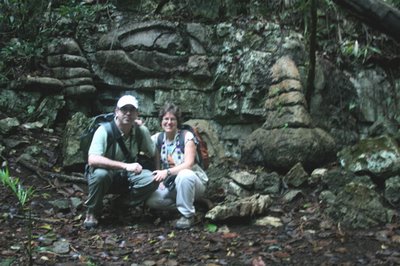
photo by Jim McCormac
A lot went on in these jungles that we know almost nothing about. I'm currently reading 1491
by Charles C. Mann. It's about what native societies might have been up to before Columbus "discovered America." The author ranges from Massachusetts all the way to Guatemala and Bolivia, examining evidence that the "New World" was much older, better developed and much more densely populated than we have heretofore believed. It's fascinating, but dense, and I find my eyes swimming and head nodding each night as I try to wrap my mind around the concept.
Just looking into the Maya guide's eyes, getting a nonverbal dose of the volumes he knew about birds, was a lesson in humility. We prance around with our books and optics, but he knows. I'm sorry not to have a picture of him, but sometimes I feel awkward acting touristy around someone so learned. His ancestors built that face, now smothered in jungle.






10 comments:
It's so awesome to travel within someone else's story to a place I've never been and have longed to go.
Seeing this world through your eyes and words makes me want to jump on the next bus to Ixpanpajul (Ixpanpajul....just to say it elicits breathless palpitations) or Los Tarrales, for that matter.
That Mayan face is amazing -- worth the trip alone. I am envious of your travels!!!
And I of yours, T.R. What I love is the places we have in common! Ojo Seco, for one. And, I hope, more to be discovered.
Wow. I'm sitting here in a snowdrift thinking it just might be worth the hassle of passports and lost luggage to experience this kind of pleasure.
I'm with Cathy.
When I retire...
Until then, I'll savor every post you write.
I am really enjoying the trip and am living through your eyes and writings ....it is really wonderful.
You don't just report the scenes Julie, you take us there and we can actually taste the flavor of the journey. Thanks so very much for your wonderfully descriptive and heartfelt diary of your experiences. For those of us who know we'll never experience something like that, it's priceless.
Thanks, Julie. The privilege and pleasure was mine! That manakin was quite a bird, but then again, weren't they all?
My husband and I have been reading your Guatemala posts, and we keep saying to each other, "I think it might be time to go back." We have such good memories of Tikal, Flores, and beyond, and we're finding your stories and photos inspiring to the nth degree. Thanks so much for sharing them!
hello, Julie, I have a querry for you. there is a bird that comes to my feeder in the summer that is black all over with a red cap. now, the only picture that I have found that even resembles this bird is of the red capped manakin. I know this bird is from south of the equator, and I live in Atlanta, GA, but the red capped manakin looks so much like this bird that it isn't funny!!!
I now have a digital camera and the next time I see this bird, I am going to take a picture so someone can help me identify this bird.
thanks,
Bev White
Hi, Bev!
I think it's very unlikely that the bird visiting a seed feeder would be a red-capped manakin (even if they were kept in aviculture, and able to escape, they wouldn't come to a seed feeder, as they eat fruit and insects). However, there are a number of small finches from Africa called mannikins which are kept as cage birds, could escape, and would come to a seed feeder. Confusing? Yeah!
Hint: If the bird lacks bright yellow thighs, it is not a red-capped manakin. If the bill is largeish and conical, it is a finch, and likely to be a mannikin from Africa. Do try to get a picture of the bird and I will do my best to identify it. Give me a heads up in the comments section or go to my web site (juliezickefoosedotcom) and we'll connect.
Post a Comment